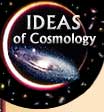
|
|
 |
New
Genesis |

|
|
|
|
What was the origin of elements heavier than Helium (atomic weight 4)? George Gamow had explained how Hydrogen and Helium could be made in the original cosmic explosion, but could not get beyond that. Then physicist Edwin Salpeter realized that in the hot interior of a star, two Heliums could momentarily combine to make Beryllium-8. To be sure, that was unstable, but sometimes it might last long enough to meet another Helium and make Carbon-12. Other elements could now be made by adding neutrons, along with the breakdown of larger unstable elements. Exploding supernovae would eventually scatter the heavy elements about a galaxy (which is why we have, for example, iron here on Earth). However, the key reaction would take place at a sufficient rate only if Carbon-12 had a very particular property (technically: an energy level just above the energy of the combining Beryllium and Helium nuclei). Fred Hoyle predictedthis property; Willy Fowler measured it and found it as predicted. Here is Gamow's comment on Hoyle's discovery: New Genesis In the beginning God created radiation and ylem. And ylem was without shape or number, and the nucleons were rushing madly over the face of the deep. And God said: "Let there be mass two." And there was mass two. And God saw deuterium, and it was good. And God said: "Let there be mass three." And there was mass three. And God saw tritium and tralphium [Gamow's nickname for the helium isotope He-3], and they were good. And God continued to call number after number until He came to transuranium elements. But when He looked back on his work He found that it was not good. In the excitement of counting, He missed calling for mass five and so, naturally, no heavier elements could have been formed. God was very much disappointed, and wanted first to contract the universe again, and to start all over from the beginning. But it would be much too simple. Thus, being almighty, God decided to correct His mistake in a most impossible way. And God said: "Let there be Hoyle." And there was Hoyle. And God looked at Hoyle… and told him to make heavy elements in any way he pleased. And Hoyle decided to make heavy elements in stars, and to spread them around by supernovae explosions. But in doing so he had to obtain the same abundance curve which would have resulted from nucleosynthesis in ylem, if God would not have forgotten to call for mass five. And so,
with the help of God, Hoyle made heavy elements in this way, but it was
so complicated that nowadays neither Hoyle, nor God, nor anybody else
can figure out exactly how it was done. |
Copyright ©. Brought to you by the Center for History of Physics, a Division of the American Institute of Physics |
|
|||||